 |
 |
 |
 |
 |
Bond, Rocky Lift New Blu Rays
Andy Reviews The Latest High-Definition Discs
Plus: New Fox Catalog, BLOOD DIAMOND and MANITOU Memories
Andy Reviews The Latest High-Definition Discs
Plus: New Fox Catalog, BLOOD DIAMOND and MANITOU Memories
While sales for the two battling high-definition DVD formats continue to be at a snail’s pace compared with plain, old-fashioned DVD, Sony’s Blu Ray format has seen a spike in recent weeks thanks to the latest adventures of James Bond and Rocky Balboa (that, plus the fact that HD-DVD basically took the first three months of the new year off, with more releases planned in upcoming weeks).
Obviously intended to be the “blue chip” for Blu Ray, Daniel Craig’s first foray as James Bond, CASINO ROYALE (***, 138 mins., 2006, PG-13), makes for a smashing high-definition DVD that also, unquestionably, ranks as one of the format’s most satisfying releases to date.
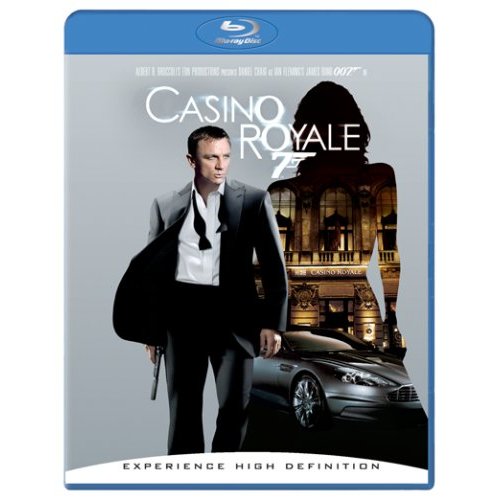
This franchise “re-boot” was greeted with enthusiasm around the world, effectively introducing Craig as a tough, no-holds-barred Bond at the start of his service to Her Majesty’s government. Paul Haggis worked with series veterans Robert Wade and Neil Purvis in penning this first serious adaptation of Ian Fleming’s novel (previously produced outside the Eon spectrum as a misbegotten 1967 all-star comedy from producer Charles K. Feldman), following Bond’s first mission as he tracks down nefarious terrorist financier Le Chiffre (Mads Mikkelsen), who’s looking to hold a high-stakes poker match to replenish his fortune.
Under the “supervision” of M-assigned treasury agent Vesper Lynd (Eva Green), Bond ultimately heads to Montenegro to play in a poker match that would likely keep all late-night cable viewers glued to the edge of their seats.
Directed by Martin Campbell (who helmed Pierce Brosnan’s first Bond, “Goldeneye”), “Casino Royale” certainly goes to great lengths to differentiate itself from the effects-laden Brosnan pictures. The famous, introductory gun barrel logo is nowhere to be found; there’s no comic relief from Q; David Arnold’s score is light on the 007 theme quotations; and aside from Judi Dench’s re-appearance as M (ultimately an unnecessary touch), this Bond is more like a “Bourne” with its bloody violence and heart-pumping action sequences.
Craig looks the part and provides a superb performance as a Bond that’s as uncompromising as any prior interpretation of Fleming’s suave spy, but also displays a vulnerable side during the picture’s effective love story, with Green serving as a fine leading lady. The movie’s antagonist is a bit on the weak side, though, with Mikkelsen’s performance never rising to the level of the classic Bond villains, while Jeffrey Wright is well-cast but under-utilized as Felix Leiter.
“Casino Royale” isn’t entirely successful -- despite some marvelous sequences and Craig’s excellent debut performance, one senses that the filmmakers were trying hard -- too hard -- to give this Bond an “edge.” The grainy pre-credits sequence doesn’t quite come off, while a lengthy torture scene screams “Bourne Identity,” a movie which this 007 was obviously patterned after in its humorless tone and sometimes explicit violence. Structurally, the film is always entertaining but loses its hold during its final third, with a somewhat muddled climax and string of endings that nearly convinced me that I was watching a Peter Jackson film.
Despite the missteps (with the newly-implemented gritty tone, I also could have lived without Judi Dench’s re-appearance as the increasingly-motherly M), “Casino Royale” certainly lays the groundwork for a fantastic new series of James Bond adventures ahead. If the tone could be tweaked just a bit -- and back towards the tradition which Eon established several decades ago (a bit lighter and less reliant on sadistic elements) -- the potential is certainly there to make a classic 007 film in the Craig era.
Sony has issued 2-disc standard-edition DVDs for “Casino Royale” (which racked up $167 million in domestic box-office and nearly $600 million worldwide), as well as a deluxe Blu-Ray edition which smokes both of the regular DVDs in its presentation.
The transfer looks absolutely smashing in 1080p, providing layer upon layer of three-dimensional detail that’s as sensational as any disc I’ve seen yet from the new HD formats. The larger your set, the more striking the differences will be between it and the standard-definition version, and the uncompressed PCM 5.1 sound is likewise packed with detail, providing a marvelous sound stage for David Arnold’s excellent score (to say nothing of the marginal Chris Cornell theme song).
Extras aren’t in abundance but at least are shared in common with the standard DVD releases. A 25-minute look at the conception of the film, and Craig’s casting, forms the centerpiece of “Becoming Bond,” while another half-hour featurette examines the movie’s production. These are okay, albeit mostly fluffy in nature, and a 50-minute TV special, “Bond Girls Are Forever” (hosted by the lovely Maryam d'Abo), presents more of the same, though it IS great to see recent interviews with some of the loveliest females to appear in the series.
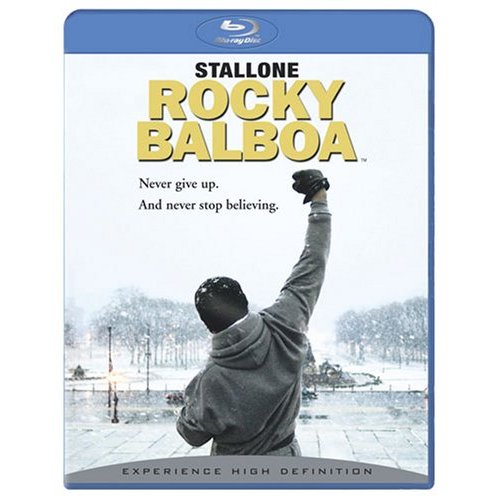
A music video of Cornell’s song rounds out the disc, which looks spectacular and comes highly recommended for any Bond fan with an HDTV.
Also new from Sony is another spectacular Blu Ray release, this time following ROCKY BALBOA (***½, 104 mins., PG) in his final bout in the ring.
I admit up front that I was hoping Sylvester Stallone’s sixth and final go-around as Rocky, the Italian Stallion from Philadelphia, would turn out to be a worthwhile endeavor. The trailers looked absurd, the concept sounded ridiculous, but nostalgia can be a powerful beast and I found myself rooting for “Rocky Balboa” to prove to be the underdog cinematic incarnation of, well, Rocky himself.
Amazing as it may seem, and personal well-wishes for the project aside, Stallone really did succeed with his $70 million sleeper hit: this is a heartfelt, soulful film that truly does harken back to the original Oscar winner, now 30 years old, in how it portrays its lead character and his unflinching desire to overcome obstacles of any kind.
Now older, wiser, and living day to day without the light of his life (Talia Shire’s Adrian has been deceased for several years at the start of the film), we meet Stallone’s hardened but still sweet and likeable big lug managing a restaurant named in honor of his late wife. He still sees Paulie (Burt Young), who’s still employed at the meat factory, but wants to see more of Robert, Jr. (Milo Ventimiglia), who’s now grown up and working in the city at a corporate job, in the shadow of his famous pop.
Rocky does get a spark after he reunites with “Little” Marie (Geraldine Hughes), the girl he teased back at the start of the 1976 original, who’s now working as a bartender in one of the less savory corners of South Philly. Marie has a teen son nick-named “Steps” (James Francis Kelly III) who Rocky takes a shine towards, promptly perking up Balboa, ever soul-searching despite having climbed to the top of the heavyweight division so many years ago.
When an ESPN computer-generated match-up pits Balboa against today’s current reigning champ Mason Dixon (Antonio Tarver), Rocky feels inspired to maybe get back into participating in local fights -- that is, until Dixon’s promoters come to town with the idea of actually pitting Rocky and Dixon together in a real boxing exhibition match...
One of the first things that instantly hits home in “Rocky Balboa” comes during the film’s opening: Bill Conti’s beautiful, haunting piano underscore reprises numerous themes from the composer’s previous series efforts, punctuating Rocky’s return to the locales where he first courted Adrian in the original “Rocky.” There’s a genuine sense of bittersweet emotion in these moments, with Stallone’s direct-from-the-heart dialogue ramming home a sense of love and loss.
Speaking of Stallone, he’s tremendous here, and one can forgive the movie’s over-abundance of speeches since it’s obvious that “Rocky Balboa” comes from the heart. Quite unlike many of the later “Rocky” sequels (III and IV in particular), the focus here isn’t on the ring or the big climactic fight (which still delivers the goods but isn’t vital to the outcome or the over-riding message) but rather the characters. Stallone’s script is as good as anything he’s ever written, illustrating Rocky’s pain over the loss of Adrian and the disconnect with his son, but also how the human spirit keeps going in spite of life’s abundant challenges. It’s easy to call the film uplifting, but “Rocky Balboa” truly is that -- and capped with a “Gonna Fly Now” montage that proves as irresistible as the picture itself.

It certainly helps that Stallone has matured as a director (sequences contrasting Rocky with Dixon and his entourage are nicely done), and also that the supporting cast is excellent and is given something to do: Hughes is superb as Marie, who compliments Rocky in a quietly understated relationship that one senses could lead to something more than friendship, while the performances of Kelly as her son and Ventimiglia as Rocky, Jr. mesh perfectly with Stallone. Young gets to portray a sympathetic and equally adrift Paulie (plus speak the film’s funniest lines), while old friends Tony Burton and even Pedro Lovell (a former boxer who played Spider Rico in the opening moments of the first film) lend further support.
While the movie seems to be a bit lean in its editing (a little more exposition wouldn’t have hurt the climactic bout as well as Rocky’s relationships with Rocky Jr. and “Steps”), this is a fully satisfying finish to the “Rocky” franchise and -- even more so -- a life-affirming and emotional piece that also marks some of Stallone’s finest work as a filmmaker and actor.
Sony’s Blu Ray DVD is likewise a winner. Stallone’s insightful, consistently interesting commentary highlights the supplemental content, which also includes a look at the production, some outtakes, and several deleted scenes, including an alternate ending (which wisely wasn’t used). The 1080p transfer is every bit as pungent as you’d anticipate, better capturing the cinematography and texture of the film’s visuals than even the theatrical print I saw last December. Unquestionably recommended!
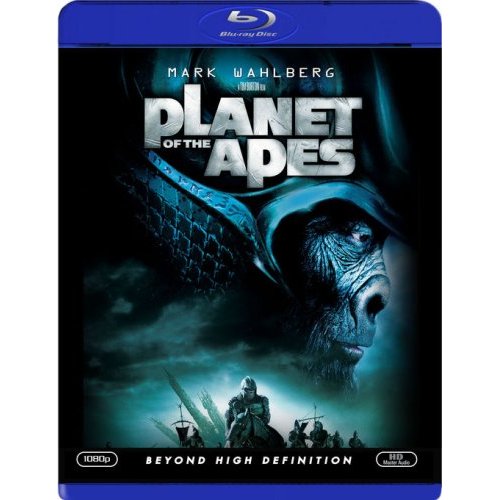 Among other recent releases, Fox has also brought Tim Burton’s PLANET OF THE APES (***, 2001, 119 mins., PG-13) to Blu Ray in a generally satisfying presentation that Burton aficionados should enjoy.
Among other recent releases, Fox has also brought Tim Burton’s PLANET OF THE APES (***, 2001, 119 mins., PG-13) to Blu Ray in a generally satisfying presentation that Burton aficionados should enjoy.The movie has become something of a forgotten film over the years, despite strong box-office receipts, and in spite of being a hated picture among original series fans, this “Apes” is nevertheless still worth seeing. One aspect that the Blu Ray version handles better than the previous DVD is that the movie’s dark cinematography is obviously far better represented in the high-definition transfer. It’s easier to follow the action and appreciate the artistry of cinematographer Philippe Rousselot in the Blu Ray version, which also includes a commentary by Burton, the trailer, a 5.1 DTS HD soundtrack and bonus trailers.
Probably not a “reference quality” disc but still a substantial upgrade on the standard-definition DVD, and worth a viewing for Burton fans and aficionados of this entertaining “re-imagining.”
Finally, Disney has added a pair of recent box-office successes to their Blu Ray roster:
CHICKEN LITTLE (**½, 81 mins., 2005, G; Disney): Cute, if unmemorable, Disney CGI feature for the little ones does feature a suitably appealing little protagonist (voiced by Zach Braff), whose penchant for misguided warnings takes a turn when actual alien visitors descend from the skies above. On the one hand, “Chicken Little” -- the studio’s first “solo” (non-Pixar) foray into CGI -- lacks the cross-over appeal that the best “family” films have had in recent years, opting to play it fairly straight and directly to its target audience. On the other, it’s somewhat refreshing to see a feel-good kids’ feature made without the winking sarcasm of the likes of “Shrek” and other PG-rated efforts; “Chicken Little” might provide mild amusement for adults but it’s perfect for children and on those grounds I heartily recommend it. Disney’s Blu Ray edition sports a gorgeous color transfer and -- how about this? -- new supplements! Included among the extras are new deleted scenes, a freshly added commentary track, a Making Of featurette and music video.
FINDING NEVERLAND (***½, 2004, 101 mins., PG; Buena Vista): Johnny Depp has proven to be one of the few actors working today who can take a variety of roles and successfully embody each and every one of the diverse characters he plays. Whether it’s a drug czar in “Blow,” or a veritable Captain of the Seven Seas in “Pirates of the Caribbean,”or Ichabod Crane in “Sleepy Hollow,”Depp dives into his various portrayals and, unlike most of today’s stars, never comes across as merely playing himself.
Depp’s eloquent, beautifully restrained portrayal of “Peter Pan” playwright J.M. Barrie is yet another gem in his canon, and now Disney has brought “Finding Neverland” to Blu Ray in an excellent high-definition presentation.
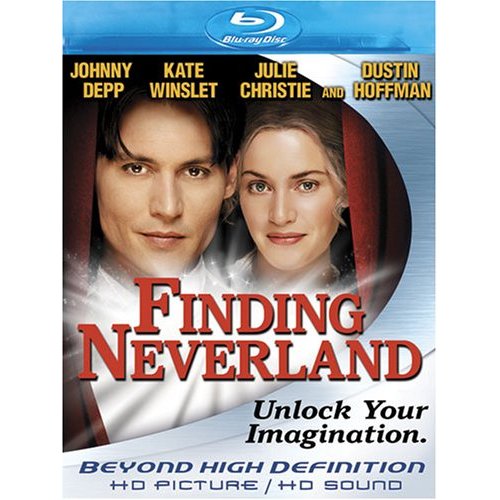
A lost soul whose wife (Radha Mitchell) is a stuffy socialite who can’t relate to her husband’s creative streak, Barrie’s world changes when he strikes a relationship with four father-less boys of widow Kate Winslet. Finding in them a vibrancy that stirs his writing, Barrie begins his creation of “Pan” at the same time his relationship with his wife falls apart and metropolitan London stirs rumors of his involvement with Winslet and her children.
Beautifully photographed by Roberto Schaefer, designed by Gemma Jackson and scored by Jan A.P. Kaczmarek, “Finding Neverland” is a lovely film less about how “Peter Pan” was made than about Barrie and the children whom he essentially adopted as his own. David Magee’s script, based on a play by Allan Knee and “inspired” by true events, paints an introspective picture of a man, his creative process, and the happiness he ultimately finds not through his stagnant marriage but rather in a group of children.
The film, directed by Marc Foster, has an enormous amount of moving sequences and a touching ending that will have you reaching for the Kleenex, but fortunately not in a sappy melodramatic sense. “Finding Neverland” garners genuine emotion through the performances of its cast, particularly Depp, who’s great here, and Julie Christie, as Winslet’s domineering, though ultimately sympathetic mother, who wants the best for her family and believes only she can provide it.
“Finding Neverland” is a film that touches upon a wealth of subjects, from the death of a loved one to the birth of the creative process and the joy of human relationships. Barrie embraced the joy, sadness, and vitality of life in his work, something that the film captures magnificently in what was easily one of the finest pictures of three years ago.
Disney’s new Blu Ray release includes commentary, outtakes, several featurettes, deleted scenes and a Making Of segment. The new high-definition transfer is quite good and makes a superb film even more satisfying on home video.
Both this and “Chicken Little” also offer top-notch PCM 5.1 soundtracks as well.
Fox Catalog Titles
Fox’s latest batch of catalog titles on “regular flavor” DVD ought to please fans of ‘60s and especially ‘70s cinema.
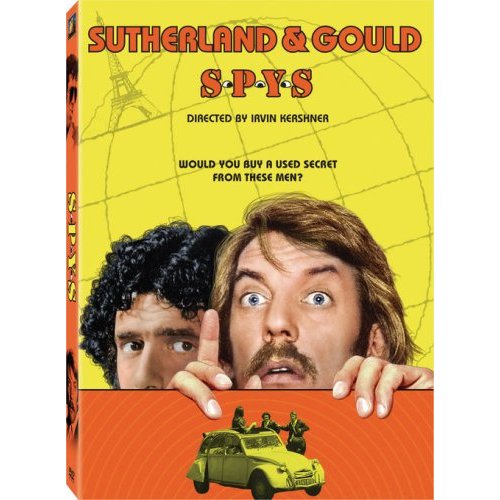 I can’t say that I’m particularly fond of either S*P*Y*S (*½, 1974, 87 mins., PG) or ROYAL FLASH (**½, 1975, 102 mins., PG),
but I can still express an appreciation that these under-achievers from
the mid ‘70s have not only been preserved here for their
respective fans on DVD, but with a good amount of extras as well.
I can’t say that I’m particularly fond of either S*P*Y*S (*½, 1974, 87 mins., PG) or ROYAL FLASH (**½, 1975, 102 mins., PG),
but I can still express an appreciation that these under-achievers from
the mid ‘70s have not only been preserved here for their
respective fans on DVD, but with a good amount of extras as well.“S*P*Y*S” was the ill-fated reunion of “M*A*S*H” stars Donald Sutherland and Elliott Gould, who teamed up in this would-be slapstick thriller from director Irvin Kershner and producers Irwin Winkler and Robert Chartoff. The Fox ad campaign promised that what Gould and Sutherland did for the military in “M*A*S*H,” they’d do for the CIA in “S*P*Y*S,” but as you might anticipate, there’s little in common between the two films on any level outside of its two stars, who do, at least, exhibit a breezy chemistry here.
Sadly, the script (credited to Malcolm Marmorstein, Lawrence J. Cohen and Fred Freeman) is a rambling wreck and the resulting film one of those infamous, star-driven misfires that just happens every now and then. When even Jerry Goldsmith’s manic, borderline-obnoxious score fails to lift the action, you know you’re in trouble (Goldsmith’s score was a replacement for John Scott’s original music, which is apparently retained in some European prints, but regrettably is not presented here for comparison’s sake).
Fox’s DVD sports a 20-minute (!) Making Of retrospective, offering new interviews with Kershner, Gould, and others, reflecting on the production and the movie’s relevance in light of the current state of world affairs (nice try, but it’s definitely a stretch!). One of Kershner’s vintage U.S. government documentaries, “The Road of a Hundred Days,” is also presented with the director’s comments, along with a still gallery and the original trailer, which predictably goes to great pains to compare the film with “M*A*S*H.” The 1.85 (16:9) transfer seems a bit soft but that’s likely due to the age of the elements, while 2.0 stereo and mono soundtracks round out the presentation.
A commentary discussion between star Malcolm McDowell and Nick Redman is the chief highlight of Fox’s presentation of “Royal Flash,” to date the only filmed adaptation of George MacDonald Fraser’s highly regarded “Flashman” novels.
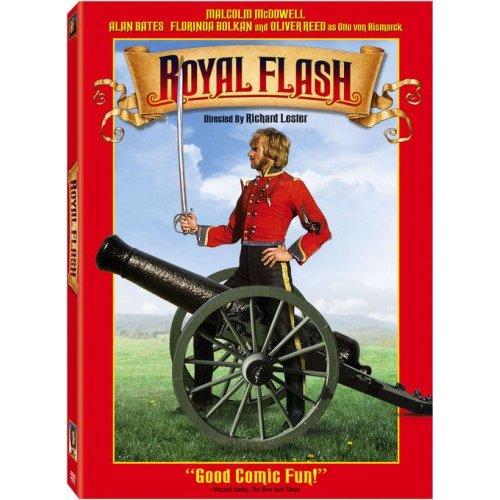 This
1975 period romp seemed to have all the elements in place for a grand
time (co-stars include Alan Bates, Oliver Reed, and “guest
stars” Lionel Jeffries, Alastair Sim, Britt Ekland among others),
with director Richard Lester following his “Musketeers”
pictures with another comedic swashbuckler, and again working with
Fraser on the screenplay.
This
1975 period romp seemed to have all the elements in place for a grand
time (co-stars include Alan Bates, Oliver Reed, and “guest
stars” Lionel Jeffries, Alastair Sim, Britt Ekland among others),
with director Richard Lester following his “Musketeers”
pictures with another comedic swashbuckler, and again working with
Fraser on the screenplay.For whatever reason, though, the movie doesn’t quite work, despite some effective moments and amusing gags. I’ve tried on several occasions to make it through “Royal Flash” and each time have struggled to do so; at 102 minutes the movie feels stretched thin, its various attributes failing to gel the way Lester’s predecessors did.
That said, aficionados of “Royal Flash” will love Fox’s DVD. The commentary is consistently interesting while a pair of featurettes (“Inside Royal Flash,” “Meet Harry Flashman”) sport new interviews with Fraser, McDowell and others. The original trailer, a still gallery, and an isolated score/FX track round out the supplemental side, with the movie looking again a bit “soft” in 16:9 (1.85) widescreen with 2.0 stereo and mono soundtracks, offering a classical-quote heavy score from Ken Thorne.
It’s taken a long time for the original BEDAZZLED (***, 1967, 104 mins., PG-13) to reach DVD, but this goofy Dudley Moore-Peter Cook affair -- directed in glossy widescreen by Stanley Donen -- has at last reached DVD on these shores as yet another excellent Fox catalog title.
Though dated in many respects (as a relic of the late swinging ‘60s the film does function beautifully), this “Bedazzled” is leagues better than the 2000 Brendan Fraser remake, here starring Moore as a cook who agrees to sell his soul to the Devil (Cook) after striking out on true love with waitress Eleanor Bron.
Raquel Welch makes for a most fetching Lust in a movie that screams “Mod!” in its editing, music and fashion, but still holds up thanks to Moore and Cook’s perfectly-pitched comic timing.
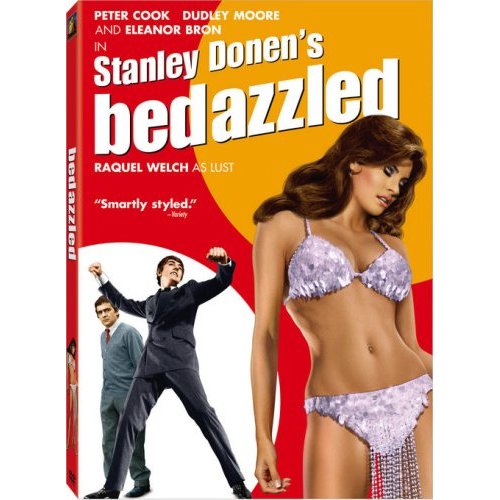 Fox’s
long-overdue DVD features an excellent 16:9 (2.35) transfer with 2.0
stereo and mono sound; several featurettes including a vintage clip of
Cook and Moore on “The Paul Ryan Show”; the trailer; a
still gallery; and an interview with Harold Ramis, who directed the
remake.
Fox’s
long-overdue DVD features an excellent 16:9 (2.35) transfer with 2.0
stereo and mono sound; several featurettes including a vintage clip of
Cook and Moore on “The Paul Ryan Show”; the trailer; a
still gallery; and an interview with Harold Ramis, who directed the
remake.Last but not least among Fox’s early April catalog titles is the “Special Music Edition” of ALL THAT JAZZ (**½, 1979, 123 mins., R), the self-indulgent, challenging, mostly-autobiographical film from director Bob Fosse that ultimately wears out its welcome.
Still, Fosse fans would do well to check out Fox's new DVD, which offers a new transfer, 5.1 soundtrack, and some fresh supplements -- with a couple of caveats.
Roy Scheider plays Fosse's alter-ego, a theater director who boozes too much, smokes too much, womanizes too much, and works too hard. His failing health results in Scheider alternating between reality and fantasy, where a harbinger of death appears in the form of Jessica Lange (whom Fosse was involved with at the time of its production). The production numbers range from realistic, expertly-executed set-pieces (such as the movie's stellar opening, set to George Benson's "On Broadway") to excessive and gaudy sequences with naked bodies and loud late '70s rock music.
For many, a little of “All That Jazz” will go a long way, though the movie has predictably developed a sizable cult following among Fosse devotees. Scheider's strong performance carries much of the movie, but at a little over two hours, the film is ultimately too self-indulgent for its own good.
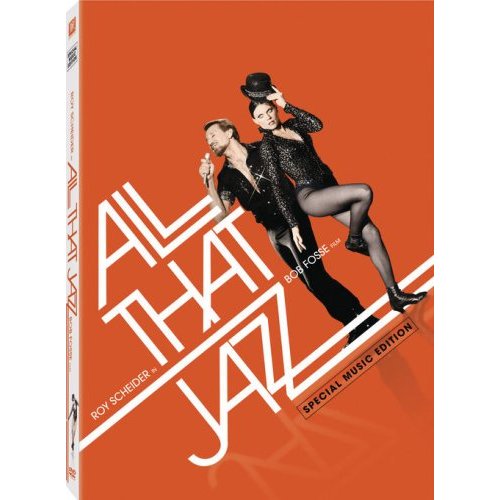 In a move that will frustrate completists, this new “Music
Edition” drops the theatrical trailer as well Roy
Scheider’s sporadic commentary track from the original DVD, plus
the vintage on-set clips of Scheider and Fosse at work. It
adds a new commentary track with editor Alan Heim, a pair of
featurettes (“Portrait of a Choreographer” and
“Perverting The Standards”), photo galleries, and a
featurette on Benson’s performance of “On Broadway.”
In a move that will frustrate completists, this new “Music
Edition” drops the theatrical trailer as well Roy
Scheider’s sporadic commentary track from the original DVD, plus
the vintage on-set clips of Scheider and Fosse at work. It
adds a new commentary track with editor Alan Heim, a pair of
featurettes (“Portrait of a Choreographer” and
“Perverting The Standards”), photo galleries, and a
featurette on Benson’s performance of “On Broadway.”Visually, the 16:9 transfer seems better balanced than the original DVD, while the sound has been reprocessed for 5.1 and is a step up from its predecessor as well. As to why certain extras were left off this release, you’ll have to ask the powers-at-be for the reason.
BORAT (**½, 84 mins., 2006, R; Fox): Sacha Baron Cohen’s Kazakh hero became an international sensation after Cohen’s semi-improv’ed “Borat” feature scored huge numbers at the box-office. To be fair, though, “Borat” is best viewed in small doses, Larry Charles’ film offering some utterly hysterical moments from time to time, and Cohen being uproarious when the situation warrants. The problem is that the feature is awfully fragmented, with weak connecting tissue between the various “skits.” Intermittently hilarious but generally over-rated nevertheless. Fox’s DVD is light on supplements (you can sense them being held back for a subsequent release), with deleted scenes, a “music infomercial” and “Global P.R. Tour” featurette comprising the extras. The 1.85 (16:9) transfer is fine, as is the 5.1 Dolby Digital sound.
New From Warner Home Video/New Line
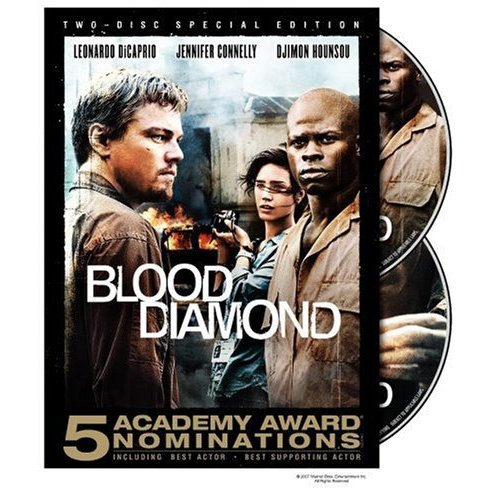 BLOOD
DIAMOND: 2-Disc Special Edition (**½, 2006, 143 mins., R;
Warner): Well-meaning but underwhelming, sprawling action vehicle from
director Edward Zwick.
BLOOD
DIAMOND: 2-Disc Special Edition (**½, 2006, 143 mins., R;
Warner): Well-meaning but underwhelming, sprawling action vehicle from
director Edward Zwick. In Civil War-era Sierra Leone, a mercenary (Leonardo DiCaprio) teams up with a fisherman (Djimon Hounsou) looking for his son -- captured, as he was, by rebel forces – while both try and track down a rare pink diamond Hounsou had previously found while in captivity.
Hounsou’s strong performance grounds the movie (I never really believed DiCaprio’s accent or “tough guy” performance), which also boasts superb cinematography by Eduardo Serra. Ultimately, though, the movie is undone by a less-than-compelling script and ill-advised supporting characters like Jennifer Connelly’s female lead, which doesn’t feel comfortably integrated into the drama. There are some excellent moments here and there, but the cumulative result is less than the sum of its parts.
Warner’s 2-disc Special Edition contains a shockingly inferior 16:9 (2.35) transfer that exhibits constant digital artifacts, at least when viewed on large digital televisions. I could not believe the amount of problems inherent in the transfer, and I tried the disc in two different upconverting players I own to verify the issues. Sadly, both resulted in an often-pixelated image with visible “ringing” around objects and a striking lack of background detail. Whether this is the result of a bad batch of discs from the plant or just a poor mastering job, we’ll have to see.
Supplements on the double-disc set are quite good, though, including commentary from Zwick, several featurettes, the trailer, a music video, and other goodies. Hopefully the HD-DVD version, when it is released, will fare better from a visceral standpoint.
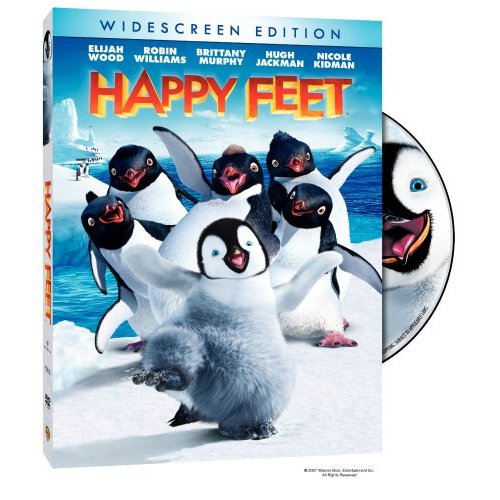 HAPPY FEET (**½, 108 mins., 2006, PG; Warner): You’ve
got to hand it to George Miller. Between “Babe: Pig In The
City” and now “Happy Feet,” Miller has at least
carved himself a distinction as being a director who’s introduced
some of the most maudlin elements ever seen in so-called
“family” films.
HAPPY FEET (**½, 108 mins., 2006, PG; Warner): You’ve
got to hand it to George Miller. Between “Babe: Pig In The
City” and now “Happy Feet,” Miller has at least
carved himself a distinction as being a director who’s introduced
some of the most maudlin elements ever seen in so-called
“family” films.Not that “Happy Feet”’s borderline-disturbing elements entirely ruin what surrounds it -- a formulaic but well-animated, bouncy CGI affair about a lonely penguin banished from his tribe after exhibiting signs that he wants to tap dance. Well-worn (read: pedestrian) messages about self-awareness, pride and individuality come into play, along with some vibrant musical numbers (kudos to John Powell for his energetic score), but the movie stumbles in its final third, ending bizarrely with, of all things, the UN trying to figure out what the significance of the tap-dancing penguins is. You could say it comes out of left field (pun intended), but prior to that “Happy Feet” is at least a cut-above for its genre, and kids probably won’t even care about the in-your-face political content.
Warner’s Widescreen edition DVD features a marvelous 16:9 (2.35) transfer with a rollicking 5.1 Dolby Digital soundtrack. Extras include two new animated featurettes, a talk with Savion Glover, music videos, and a classic WB cartoon (“I Love to Singa”).
THE NATIVITY STORY (***, 101 mins., 2006, PG; New Line): Handsomely-mounted, if slow-moving, retelling of the Nativity story, with an excellent international cast (Shohreh Aghdashloo, Keisha Castle-Hughes, Oscar Isaac) and a superb, understated score by Michael Danna carrying the drama. Director Catherine Hardwicke’s movie was dismissed by a fair amount of critics, but performed moderately well at the U.S. box-office and ought to attract an even wider audience now on video. New Line’s DVD, released just in time for Easter, includes an atmospheric 16:9 (2.35) transfer with 5.1 Dolby Digital sound. Extras are limited to a pair of trailers. Well worth a viewing.
Also New From Fox & Other Capsules
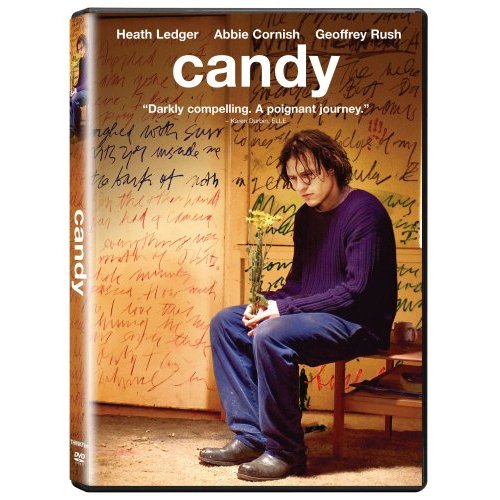
PEBBLE AND THE PENGUIN: 2-Disc Edition (**½, 1995, 74 mins., G; MGM/Fox): Undoubtedly released to coincide with the debut of “Happy Feet,” Fox’s two-disc edition of the 1995 Don Bluth animated release will be a must for fans of the picture. The new 16:9 transfer is solid, as is the 5.0 Dolby Digital soundtrack; I’m not sure what the reason for the two-disc set was (special features are just okay, offering a Making Of featurette and look at the music, plus interactive games for kids), but this is at least a nice package for one of Bluth’s better, post-“Nimh” efforts.
LITTLE ROBOTS: Reach For The Sky (2003, 44 mins., Fox): More animated adventures for kids from the popular British series, presented in full-screen with 2.0 Dolby Stereo sound. Recommended, though a bit on the short side at 44 minutes.
JUMP IN! (85 mins., 2006, Disney): Special Edition of the Disney Channel original movie features Corbin Bleu (from “High School Musical”) as an aspiring boxer who helps out neighbor Keke Palmer (“Akeelah and the Bee”) with her Double Dutch jump rope team. Cute, inoffensive family movie that Disney has brought to DVD in a “Freestyle Edition” showing teens how to jump rope, and offering the standard supplements (Making Of featurette, music video) you’d anticipate. The full-screen transfer and 5.1 Dolby Digital soundtrack are both fine, and Frank Fitzpatrick’s score isn’t half-bad, either.
CANDY (***, 2006, 108 mins., R; ThinkFilm): Excellent performances from Heath Ledger and Abbie Cornish carry this Australian import. Ledger plays a poet who falls for art student Cornish, but their attraction is at least partially fueled by their growing addiction to heroin. Director Neil Armfield (who co-wrote with Luke Davies, adapting his novel) has produced a realistic, well-performed character study that’s worth tracking down on DVD. ThinkFilm’s release is filled with extras, including commentary, two featurettes, the trailer, a 16:9 widescreen transfer and 5.1 Dolby Digital sound.
MANITOU Follow Up
I’ve received a few responses in regards to my review of “The Manitou” last week.
First up, for all bad movie buffs, there’s a screening of the film in L.A. during the “So Bad It’s Good” Film Festival this week! Details follow, as well as a recollection from John Archibald about this entertaining 1978 William Girdler epic.
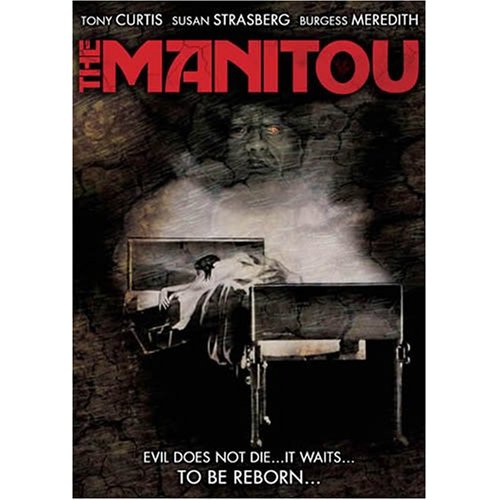
SBIG Film Fest presents:
THE MANITOU - starring Tony Curtis
Friday, March 30th at Midnight
The Vista Theater
c4473 Sunset Drive
Los Angeles, CA 90027
Admission - $10, cash only
Our special guest is Stella Stevens, one of the stars
of the movie. She will take part in a Q&A moderated
by none other than horror journalist, Ryan Rotten
Turek, who will be our special host for the evening.
For more info go to: www.myspace.com/sbigfilmfest
From John Archibald:
Hi Andy,
Appropriately enough, I originally saw "The Manitou" as part of a double bill at one of those seedy movie theatres on 42nd St., in New York, during its original run. That was back when the very term, "42nd St.," was not synonymous with Broadway-style hoofers, but rather seedy second-run movie houses, interspersed with various sex businesses.
To its credit, I suppose, "The Manitou" was, as I recall, the top half of the double bill playing at that theatre. Can't remember the other picture, or even if I stayed for it. At the time, I thought "Manitou" had an entertaining premise, and at that time, it seemed everyone was jumping on the "Exorcist" band wagon. (I can remember another, cheaper knockoff, called "Abby," about yet another possessed nubile teen, which I found hilarious, as it was also the name of my then girlfriend. I never saw it, and have never heard of it since.)
In fact, I was just on 42nd St. this past weekend, going to stage shows. The whole street has been gentrified to the point of unrecognition. I couldn't even tell which theatres had been there during the days I lived in New York. There had been so many theatres on that street, that the entire street was illuminated from one end to the other by their marquees. The theatres themselves could be raucous, as only New York audiences can be, but they were a haven for people with not much money, who could see a movie and experience the fabled "theatre district" vicariously, without having to invest very much. (Some of them were astounding for their faded grandeur; I can remember marvelling at the Art Nouveau woodwork all over the then-sleazy New Amsterdam Theatre, all of which has been mercifully restored.)
So, "The Manitou," given its tone, was entirely at home in that environment, the perfect place, it would seem, to see such a film and enjoy it for what it is, unpretentious and entertaining.
NEXT TIME: CHILDREN OF MEN! Until then, don't
forget
to drop in
on the official Aisle Seat Message
Boards, check out the new Aisle Seat Blog, and
direct
any emails to the
link
above
.


